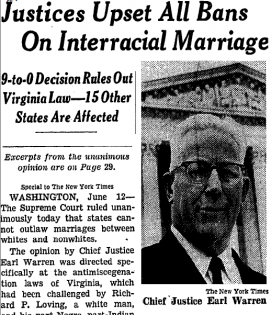Renee Romano teaches history at Oberlin College and she is the author of Race Mixing: Black-White Marriage in Postwar America (Harvard University Press, 2003), and co-editor of The Civil Rights Movement in American Memory (University of Georgia Press, 2006). Her new book, Racial Reckoning: Prosecuting America's Civil Rights Murders (forthcoming from Harvard University Press in fall 2014) explores the contemporary prosecutions of civil rights era crimes.
On June 12, 1967, the U.S. Supreme Court delivered a groundbreaking decision in the aptly named case, Loving v. Virginia. Responding to a challenge to a Virginia law that barred interracial marriages, the Supreme Court ruled that state laws that made it illegal for whites and nonwhites to marry were unconstitutional.
“There can be no doubt that restricting the freedom to marry solely because of racial classifications violates the central meaning of the Equal Protection clause,” Chief Justice Earl Warren wrote in the unanimous decision.
With the stroke of a pen, the Supreme Court overturned centuries of common practice and its own legal precedent.
The colony of Virginia had enacted the first law punishing interracial marriage in 1691 in an attempt to prevent what it called the “abominable mixture and spurious issue” produced by unions between whites and nonwhites. Miscegenation laws proved vital for establishing racial boundaries and for constructing a racial hierarchy that placed whites above people of color. All but nine of the fifty states outlawed interracial marriage at some time in their history. These laws were not limited to the South—they existed at different historical moments in states ranging from Massachusetts to California, and they variously outlawed marriages between whites and those defined as black, Asian and American Indian. What they had in common was a shared intent in protecting the status of whites and communicating the subordinate position of nonwhite groups.
IMAGE: The New York Times, June 13, 1967. Read the full article here.


